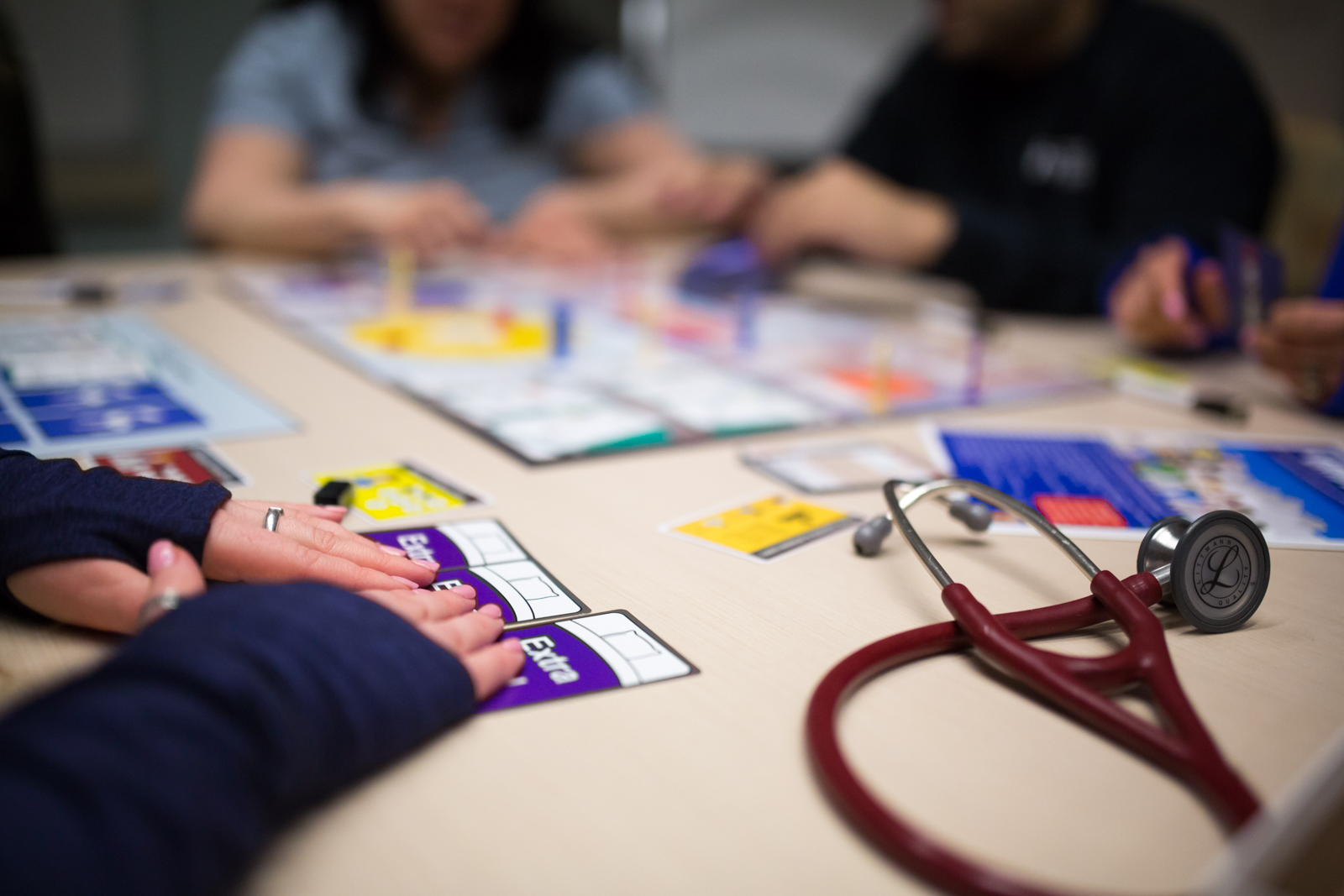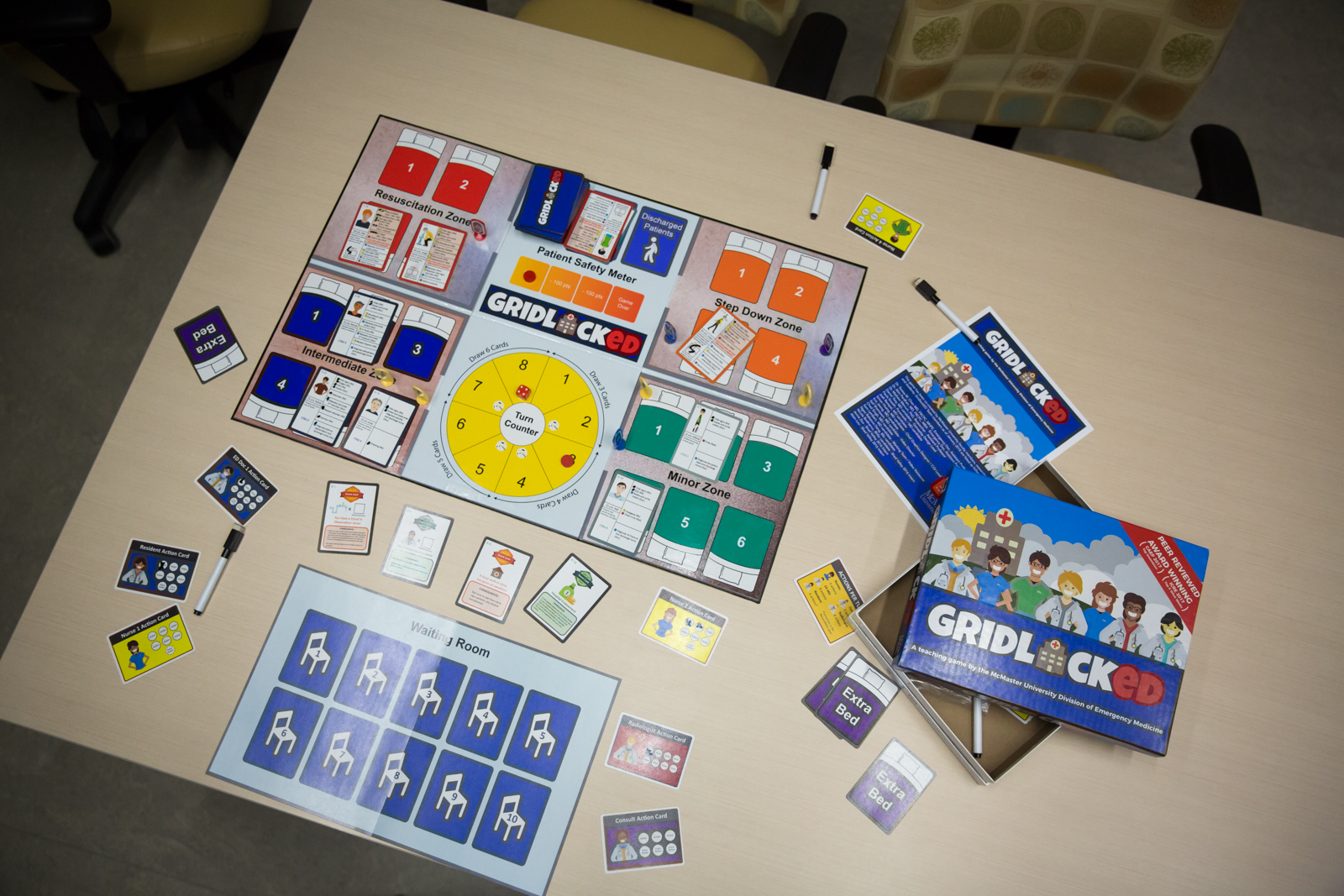Written by Sonja Wakeling. Edited by Dr. Teresa Chan.
Everything I know about ED management I learned from… A Board Game?

GridlockED is an innovative board game that fosters teamwork, knowledge acquisition and application, and problem-solving skills. Developed by clinician educators and trainees, it was designed to simulate real-life settings in an emergency department within a risk-free learning environment. In the healthcare field, it is impossible to allow junior learners full reign of an emergency department, yet they require some level of experience if they are to be responsible and effective when they are practicing and learning. It is imperative that learners exercise and develop skills in a variety of required domains, such as the Royal College of Physicians and Surgeons of Canada’s CanMEDs qualities; these include communication, collaboration, health leadership, health advocacy, scholarship, and professionalism..(1)
Learners acquire knowledge in a variety of approaches, traditionally through didactic lectures but also through other more interactive methods. There has been an important shift from classic knowledge dissemination to more active participation(2); however, finding novel ways to provide both effective and efficient acquisition assists in training a highly-qualified generation of new physicians. In recent years, there has been a surge of simulation-based learning in medical education, particularly at the level of post-graduate and undergraduate medical training.(3) Multiple studies have shown that simulations are an effective method of education; for example, increasing the learner’s confidence in addition to increasing knowledge retention both short- and long-term.(4)
GridlockED: a serious game for learners

Serious games, which Bergeron defines as an “interactive computer application, with or without significant hardware components”, are a form of simulations.(5) Instead of being designed with a set of primary winning objectives, their main objective is for the player to acquire knowledge and skills in a challenging and fun learning environment; in a situation like this, the knowledge is seemingly acquired with little effort.(6) This method of learning has recently taken off in residency education, as evidenced by the systematic review of serious gaming within the surgical field(6); however, there is limited evidence to support their utility given that the expanding use of serious gaming as a relatively new approach to medical education. This is one such area that require intensive and thorough research as a means of advancing effective teaching methods in medical education.
In the context of disaster preparedness, tabletop exercises and simulations have been a key aspect of their planning and preparations.(7) GridlockED is an example of a serious game that employs a tabletop simulation approach, which Agboola an colleagues described as one that “involves key personnel discussing simulated scenarios in an informal setting based on existing operational plans and identifying where those plans need to be refined.”(7) GridlockED can accommodate up to 6 participants, given that it is a co-operative and collaborative style of play, whose purpose is to collaborate and reason through the management of patients during a “standard” 8-hour shift in an emergency department. For those with ample professional experience, this task certainly may not seem difficult; however, as a junior learner it sets a great challenge to efficiently and intelligently manage the flow of patients.
Objectives and templates: GridlockED as a teaching tool
So, what makes GridlockED a valuable teaching tool? This low-stakes learning environment allows participants the opportunity to discuss various approaches, make mistakes (and more importantly, to learn from them), and come to understand how they might prioritize certain patients or tasks in a busy emergency department. The point is not to acquire knowledge around diseases or illness management, but rather the skill to lead and collaborate in a mission to provide effective care (and ultimately “win” the game). The beauty of this game is that this is all done outside of the department where there are no real patients, and where entrusted facilitators can help provoke discussion around challenges, successes, and errors.
In addition to the basic gameplay set-up, learning templates are being developed that focus on themed settings or situations that promote particular clinical lessons. For example, there is one theme that results in a shortage of nursing staff, forcing participants to adjust their gameplay style and therefore clinical management akin to a similar situation in a real emergency department. Another theme places you in a rural emergency department with limited resources including staff and specialists available to assist you. Furthermore, an additional template fills your department with patients, taking the game title GridlockED to a serious level. Each teaching template is led by a facilitator who helps the team delve into the decisions they make and reflect on methods to improve their future management.
Case 1 – Best Shift Ever (218 kb)
Case 2 – Rural Hospital (226 kb)
Case 3 – Where have all the nurses gone? (216 kb)
Case 4 – Safety Worries (202kb)
Case 5 – Overwhelming Diagnostic Imaging (222 kb)
Case 6 – The Critical Consultant (182 kb)
Case 7 – Night(mare) Shift (234kb)
Case 8 – Code Gridlock! (210 kb)
Download all cases at once. (1.6 MB)
Lessons learned, future patients saved
As a junior learner myself, I have taken some key learning points away from each round of GridlockED I have participated in; for example, never forget the bigger picture. The game allows you to slow down for a moment and view the whole “picture” of the department. Here, you can keep a watchful eye on both patient flow and volume, consider the challenges you are currently facing, and what you foresee may occur. Layer on top of this basic gameplay with various themed learning templates and you have yourself a robust and effective teaching tool that is also fun to engage in!
But there are many more valuable learning points I have taken away from each cycle of gameplay lend themselves to the management of a real emergency department.
- Plan ahead. It is not a good idea to leave your high acuity beds with unstable patients in them, unless you have absolutely no choice. If you cannot care for the next patient who comes in in serious condition because your beds are blocked, you (and that patient) are in trouble. And related to that, strategize to maximize the efficiency in each zone of the department.
- Prioritize sick patients. Despite patients expressing concern about wait times, there are instances where it is reasonable and indeed appropriate to delay care of low-acuity patients in favour of those who are in serious condition. If someone is waiting in an emergency department, and given the limitations of the healthcare system, it is often a good sign; that individual is not dying or in critical condition, so it means there are other patients who require more immediate attention. That is not a position anyone wants to be in, so try to wait with patience and gratitude.
- Collaborate inter-professionally. There are various roles to be played, including nursing, specialties, and learners. However, each participant playing may have a different role in the real world. Rely on their knowledge and experience, and listen to what they say. The most effective leaders know when to lead and also when to listen.
Speaking of collaboration, do not forget the limitations of each allied health or specialty role. Recognize when a professional may be in over their head and help where you can. Only so many blood vials or imaging results can be completed in a fixed amount of time. Be patient, be mindful, and have reasonable expectations.
At the end of the day, do what is best for the patients being treated. See as many patients as you can, treat as many as you can, and do your best to save everyone you can. Sometimes you cannot save everyone, but learn from each experience you have so you improve the situation for the next time you have a similar scenario.
Now that you know what is at stake… Are you up for the challenge?
GridlockED was developed by staff physicians and medical students at McMaster University in Hamilton, Ontario, Canada. Please visit https://gridlockedgame.com if you would like to learn more or purchase the game. All proceeds for the game go towards fostering further education and scholarly projects at McMaster University.
References
- Royal College of Physicians and Surgeons of Canada: CanMEDS Framework. http://www.royalcollege.ca/rcsite/canmeds/canmeds-framework-e. Accessed September 3, 2018.
- Allerly LA. Educational games and structured experiences. Med Teach. 2004 Sep;26(6):504-5.
- Bradley P. The history of simulation in medical education and possible future directions. Med Educ. 2006 Mar;40(3):254-62.
- Behar S, Upperman JS, Ramirez M, Dorey F, Nager A. Training medical staff for pediatric disaster victims: a comparison of different teaching methods. Am J Disaster Med. 2008 Jul-Aug;3(4):189-99.
- Bergeron BP. Developing Serious Games. Charles River Media: Hingham, 2006.
- Graafland M, Schraagen JM, Schijven MP. Systematic review of serious games for medical education and surgical skills training. Br J Surg. 2012;99:1322-1330.
- Agboola F, McCarthy T, Biddinger PD. Impact of emergency preparedness exercise on performance. J Public Health Manag Pract. 2013 Sep-Oct;19 Suppl 2:S77-83.